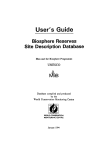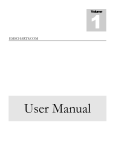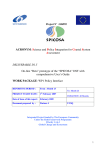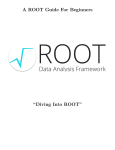Download The WadBOS ecosystem model as an example for building
Transcript
Extend training material for SPICOSA provided by Joachim Maes SPICOSA WP8 VITO contact: [email protected] The WadBOS ecosystem model as an example for building block design and model documentation Accompanying Extend material • • • WadBOSEcosystemModel_v1.mox WadBOSEcosystemModel_v3.mox WadBOSEcosystem.lix 1 1 Introduction Model formulation is the step where conceptual system knowledge is written in a more formal, mathematical form. A mathematical description can subsequently be implemented in a programming language. The translation from a conceptual and mathematical description of the dynamics of an ecosystem into the simulation software Extend is presented in this manual. A next objective of this chapter are to illustrate how a model that was made in Extend can be documented for submission. In between, we will show how returning processes can be stored in an Extend model block so as to facilitate the practice of modelling. This manual is implemented as Chapter 8 in the SPICOSA deliverable D8.4 Model building blocks and it forms a direct link to the WP4 system formulation report. In fact, the same example will be used. 2 2 The WadBOS model: concepts and formulation 2.1 What is WadBOS? WadBOS features an integrated system dynamic model representing the ecological and the economic functions of the Wadden Sea (Engelen 2004). The Wadden Sea is part of a coastal system extending from the North of the Netherlands into Northern Germany and Western Denmark. In the Netherlands, the sea is a protected nature reserve because of the important ecological functions that it fulfils. At the same time, the sea has important economic functions. Fishing, recreation, transportation, and mining are among the main economic activities. It generates employment, income, leisure, and food for many a household. The management of the different activities and functions of the sea is distributed over a great number of institutions, ranging from the municipal to the European. When decisions are to be made or policies need to be developed relative to the exploitation or protection of the area, incompatible views tend to slow down the decision-making process. In this manual, selected parts of the WadBOS model are used to illustrate how an ecosystem model can be formulated based on a conceptual description. For simplicity, we do not consider spatial information at this point. We assume a reservoir-like sea with a constant surface area and a uniform distribution of dept. 2.2 Conceptual model The conceptual model in Fig. 1 describes the flow carbon and nitrogen through a coastal zone food web. The ecosystem is represented by six state variables: Dissolved inorganic nitrogen, the stock of detritus in the water and on the sea bed, phytoplankton, mussels and birds. These state variables are coupled to each other via 11 processes: (1) mineralization of detritus in the water; (2) denitrification of detritus on the sea bed; (3) uptake of nitrogen by algae; (4) mineralization of detritus on the sea bed; (5) atmospheric deposition of nitrogen; (6) sedimentation of detritus and dead phytoplankton; (7) grazing 3 of algae by mussels; (8) phytoplankton mortality; (9) mussel mortality caused by bird predation; (10) growth of the bird population; (11) mortality of birds as a function of mussel biomass. Fig. 1. Conceptual model of an coastal ecosystem model based on the WadBOS DSS 4 Using the numbered processes, the dynamics of this ecosystem are captured by the following set of equations: dNitrogen = 1+ 4 − 2 + 5 − 3 dt dDetritusWater = 8 − 1− 6 dt dDetritus seabed = 6−2− 4 dt dPhytoplan kton = 3−8− 6−7 dt dMussels = 7 −8 dt dBirds = 10 − 11 dt 2.3 Mathematical description and implementation in Extend Next, the conceptual model is formulated using a set of coupled differential equations. The mathematical model was implemented in Extend. A first version of the model, saved as WadBOS_EcosystemModel_v1.mox, contains the explicit model code using Extend model blocks from the generic library only. The following figures show the translation of the mathematical model into an Extend model. In Extend, each state variable is solved using the integrate block, using the option Euler forward. Each state variable is initialised with a particular value, that can be filled in in the dialog of the integrate block. Models can be downloaded from the internal SPICOSA website. Notice that each process is only once coded in Model blocks. In Extend each process was given a name and that name is used to repeat processes in other parts of the model. 5 Nitrogen dynamics Equation dNitrogen = y N × (k w × DetritusWater + (k b − k deni ) × DetritusSeabed ) + dt Nitrogen AD Light − y N , A × k max × × × Phytoplankton h k + Nitrogen k L + Light N Units Parameters gram nitrogen per m3 yN factor converting carbon biomass of the detritus (ash free dry weight of organisms) to nitrogen (-) mineralisation rate of detritus in the water (per month) mineralisation rate of detritus on the seabed (per month) denitrification rate of detritus on the seabed (per month) Atmospheric deposition (gram nitrogen per month per m2), forcing function water depth (m) factor converting carbon biomass of the algae (ash free dry weight of organisms) to nitrogen (-) maximum growth rate of phytoplankton (per month) half saturation constant of the nitrogen limited algae growth (gram nitrogen per m3) Light incidence (W per m2), forcing function half saturation constant of the light limited algae growth (W per m2) kw kb kdeni AD h yN,A kmax kN Light kL 6 Extend model Dynamics of detritus in the water Equation Units Parameters mA kw v h dDetritusWater v = m A × Phytopankton − k w − × DetritusWater dt h gram carbon per m3 Extend model mortality rate of phytoplankton (per month) mineralisation rate of detritus in the water (per month) sedimentation of detritus (m per month) water depth (m) 7 Dynamics of detritus on the seabed Equation dDetritus Seabed v v = × DetritusWater + × Phytoplankton dt h h − (k b − k deni ) × Detritus Seabed Units Parameters gram carbon per m3 v h kb kdeni sedimentation of detritus and of the phytoplankton (m per month) water depth (m) mineralisation rate of detritus on the seabed (per month) denitrification rate of detritus on the seabed (per month) Extend model 8 Dynamics of the phytoplankton (Algae) Equation Units Parameters kmax kN Light kL v h g Nitrogen dPhytoplankton Light = k max × × × Phytoplankton dt k N + Nitrogen k L + Light v − − mA − [g × Mussels] × Phytoplankton h gram carbon per m3 maximum growth rate of phytoplankton (per month) half saturation constant of the nitrogen limited algae growth (gram nitrogen per m3) Light incidence (W per m2), forcing function half saturation constant of the light limited algae growth (W per m2) sedimentation of detritus and of the dead fraction of the phytoplankton (m per month) grazing factor of mussels on phytoplankton (m3 per gram carbon per month) 9 Extend model Dynamics of the mussel population Equation Units Parameters kmussel kP mmussel G Phytoplankton dMussels = k mussel × × Mussels dt k P + Phytoplankton − (mmussel − [G × Birds]) × Mussels gram carbon per m3 Extend model maximum growth rate of the mussel population (per month) half saturation constant of the phytoplankton limited mussel growth (gram carbon per m3) mortality rate of the mussels (per month) grazing factor of birds on mussels (per bird per month) 10 Dynamics of the bird population Equation dBirds kM Birds = k bird × 1 − × Birds − mbirds × × Birds dt K k M + Mussels Units Parameters numbers kbird K mbird kM maximum growth rate of the bird population (per month) carrying capacity of the bird population (numbers) mortality rate of the birds (per month) half saturation constant of the mussel inhibited bird mortality (gram carbon per m3) 11 Extend model Fig. 2. Monthly changes of the state variables of the WadBOS ecosystem model. Each of the state variables is solved in Extend and plotted to an I/O output plotter block that resides in the Plotter library (Fig. 2). The modelled time step is set to 0.001 month and the model simulates 120 months. Try to change the time step to see how this parameter affects the results. When using a time step of 1 month, the model explodes due to numerical errors. A time step of 0.1 month already yields stable results. 12 3 Model hierarchy and the design and application of model building blocks The ecosystem model as presented above works fine but it is hard to read for non modellers. Also, it requires a whole lot of clicking and dragging blocks from the generic library to the model pane, which becomes a boring and time consuming task. So we implemented two steps to facilitate the work for the modeller and the readability of the model for the non modeller. Firstly, we designed a new building block called rate limiting process. As you probably noted, the rate of ecological processes of the form dN/dt = r×N is often limited or even inhibited by resources. The growth of a mussel population is limited by available food, while a process such as denitrification is inhibited by the presence of oxygen. Several mathematical expressions limit the rate of ecological processes. The most applied are carrying capacity, functional response and the reverse of functional response (inhibition). When translating the mathematical model into Extend, it quickly becomes clear that the explicit formulation of all these rate limitations is a time consuming task, so we decided to construct a new Extend block that simply implements the basic rate limiting equations. Secondly, we made the first version of the model more accessible by combining blocks into hierarchical structures. Both steps do not alter the model outcomes. But they strongly improve the looks of the model, so that non modellers are able to read the model in an intuitive way. 3.1 Coding a new model block in Extend that enables faster modelling practice Rate limiting terms modulate the interaction between a resource and its consumer. Many formulations exist but in ecology the most applied rate limiting terms are carrying capacity, functional response and inhibition. All rate limiting terms that are used in the WadBOS ecosystem model are presented using squared brackets in the differential equations. 13 Table 1 lists the interactions between a consumer C interacts and a resource R at a rate kmax. Each time, the mathematical formulation and the implementation of that exact formulation in Extend are given. Each time when a modeller wants to include any of these rate limiting terms, he or she has to click and drag the appropriate blocks from the generic library to the model pane or copy the blocks and paste them for a second or third rate limiting process. This is time consuming and – no need to say - boring. Also, the model pane is soon loaded with blocks. Therefore, it would be interesting to encode a single block that can substitute all of the above processes. This block saves time and space. This step is done a second version of the Extend code that simulates the Wadden Sea ecosystem (WaddenSea_EcosystemModel_v3.mox). We do not repeat how to make a new block. This information is presented in the Extend User Manual and in the CoexistenceModel example. Fig. 3 shows the structure of the new block named RateLimitingProcess while the accompanying dialog is presented in Fig. 4. 14 Table 1. Rate limiting terms that modulate the maximum rate with mathematical description and implementation in Extend using the generic library and using a newly created Extend block that replaces generic blocks. The new block saves time for the modeller and needs less space on the model pane. Process Unlimited resource R Carrying capacity Mathematical description Extend code with generic blocks dC = k max × C dt dC C = k max × 1 − × C dt K Functional response type 1 dC = k max × R × C dt Functional response type 2 dC R = k max × ×C dt R + kS Functional response type 3 dC Rp = k max × p ×C p dt R + kS Inhibition kS dC = − k max × ×C dt R + kS 15 Extend code with newly created block Fig. 3. Structure of the RateLimitingProcess Extend block. The block’s icon is given in the upper left corner. Some introductory text is given in the upper right corner. More documentation is needed there but this will be the focus of paragraph. Under the model icon, two names relate to the connectors: ResourceIn and VarOut. They represent the input value into the block and the output value out of the block, respectively. The pane situated in the lower left corner contains the dialog names. The block’s dialog contains four parameters (HalfSatCont, Shapefactor, MaxRate, CarCap), one parameter with option display only (DisplayResource) two buttons (OK, Cancel), four radio buttons (Response, Response23, CaryingCapacity, Inhibition) and edible text (Comments) and finally, 12 static text items which were not given names. On the right hand site, the model code is presented. The code calculates the value for VarOut based on the parameters and the ResourceIn for four different options of rate limitation. Defaults are presented under the code. 16 Fig. 4. Dialog of the Extend Block with name RateLimitingProcess. The new block has been saved under a new library that needs to be installed (saved) in toe Extend libraries folder. The name of the library is WadBOSEcocystem.lix. 3.2 Building in hierarchy for better readability and increased intuitive understanding of the model The conceptual model is a good guide for hierarchy building. Intuitively, it seems interesting to group model blocks that calculate the dynamics of the different state variables of the model. Probably this is a good tactic of any type of model. State variables are excellent candidates to create a hierarchical structure in the model. Open the WadBOS_EcosystemModel_v3 and explore how hierarchical blocks were constructed (Fig. 5). 17 Fig. 5. Hierarchical blocks represent the state variables of the WadBOS ecosystem model. 18 3.3 Documenting the model In a final step, the model needs proper documentation so that it can act as a stand alone application. Any user should be able to open this model and find all the relevant information to use the model in the data entity itself. Extend offers several means of documenting generic Extend blocks, self made Extend blocks or hierarchical Extend blocks. 3.3.1 How to give a name to individual blocks Every Extend block can be given a name: if you click on the block, you can fill in a name in the lower left corner next to the help tab. Check Fig. 7 for the names that have been given to the blocks that make up the birds sub model. 3.3.2 How to document the newly coded Extend block RateLimitingProcess Newly coded blocks have a help tab. The help function can be used by opening the structure of the block by clicking on the block while holding the ALT key down and entering text in the upper right pane. In case of documenting a newly made block, it is essential to follow the guidelines that WP8 provides. This means that there should be concise information on the function of the model block and an explanation of the possible dialog choices and connectors. Fig. 6 gives a screenshot with the documentation of the newly made model block for rate limiting processes. The help tab starts with a very short explanation about the function of the block. Next the possible dialog choices and connectors are explained. The titles have a text size that is larger than the regular text while the dialog choice names and the connector names are in bold. 19 Fig. 6. Screenshot of the Help tab for block RateLimitingProcess that resides in the Extend library WadbosEcosystem.lix. 3.3.3 How to document the hierarchical Extend blocks Hierarchical blocks have a help tab. The help function can be used by opening the structure of the block by clicking on the block while holding the ALT key down and entering text in the upper right pane. Fig. 7 shows the help tab that was completed in order to document the hierarchical Birds block of the Wadden Sea ecosystem model. The documentation starts with a concise description of the function of the block. Next, the conceptual formulation, mathematical equations, state variables and parameters are provided. Also input and output connectors should be explained. Check also the other blocks of the case study for documentation. 20 Fig. 7. Left. Hierarchical block that groups the processes that affect the dynamics of birds in the WadBOS ecosystem model. Right. Help tab of the hierarchical block. All other blocks have been documented similarly. Click on the help tab of each hierarchical block for details 3.3.4 How to make hierarchical blocks more accessible by providing a user interface. The clone tool can be used to provide a user interface between the Extend model and the parameters that drive the model. An example is presented here for the hierarchical block that represents the dynamics of the bird population. Using the cloning tool, all the parameters were copied and placed after user defined text items. Now, a user can modify the parameters without the need of opening the particular blocks. 21 Fig. 8. Screenshot of the hierarchical block that calculates the bird population size. By using the cloning tool, a user interface can be built so that new users can enter parameters without the need of opening the Extend blocks. 22 3.3.5 How to include push buttons to enter general model information. The clone tool can also be used to add buttons to the model pane so as to include general model information, text, figures and so one. We illustrate this procedure for the WadBOS ecosystem model. We want to add a push button to the model pane with the following documentation that is based on the information that SSA teams will need to submit to the SPICOSA model database using the Model Documentation and Submission system. Basic information Model name: WadBOS Full model name: Wadden Sea Ecosystem Model version 3 Model version and status: version 3, tutorial model Latest date of revision: 12 January 2007 Does the model use a non-standard custom made Extend library? YES: WadBosEcosystem.lix Institutions: VITO Contact person: Joachim Maes Contact address: VITO, Integrated Environmental Studies, Boeretang 200, B-2400 Mol, Belgium Phone number: +32 14 335963 Fax number: +32 14 321185 E-mail address: [email protected] URL. none Technical support: Level of knowledge needed to operate model. EASY Remarks None System design Policy issue: Ecosystem dynamics Study site: no study site (tutorial model) Model description summary: This model simulates the flow of carbon and nitrogen through six compartments of the Wadden Sea ecosystem. The model has six state variables: Dissolved inorganic nitrogen, the stock of detritus in the water and on the sea bed, phytoplankton, mussels and birds. These state variables are coupled to each other by 11 processes: (1) mineralization of detritus in the water; (2) denitrification of detritus on the sea bed; (3) uptake of nitrogen by algae; (4) mineralization of detritus on the sea bed; (5) atmospheric deposition of nitrogen; (6) sedimentation of detritus and dead phytoplankton; (7) grazing of algae by mussels; (8) phytoplankton mortality; (9) mussel mortality caused by bird predation; (10) growth of the bird population; (11) mortality of birds as a function of mussel biomass. System formulation. Model resolution time horizon: 120 months but can be defined by the user temporal resolution: 1 month 23 spatial extension of the model: lumped model, spatial scale is the WaddenSea spatial resolution: State variables of the model: Click on the help file of the hierarchical blocks for information Schemes: Click on the help file of the hierarchical blocks for information Numerical solution technique. Euler forward Data input: Input data: none Forcing functions: Light and atmospheric deposition (Click on the help file of the hierarchical blocks for information) Boundary conditions: none Initial conditions: Click on the help file of the hierarchical blocks for information System appraisal. Calibration: No calibration was performed Sensitivity analysis. No sensitivity was performed Evaluation and validation. Level 5 (no evaluation at all) System output Output quantities. Bird population size User community: SPICOSA References: Engelen G (2004) Models in policy formulation and assessment: The WadBOS Decision Support System. In: Environmental Modelling: Finding simplicity in complexity, J Wainwright and M Mulligan (Eds). John Wiley and Sons Ltd, West Sussex, England. pp.257 – 271. Uljee I, Engelen G (2002) WadBOS user manual. This is the procedure to store this information in your Extend model and to make it available for other users using a button. • Open the Extend model where you want to add information. • Type in some dummy text on the model pane for instance “text” • Select the text and make a hierarchical block of the text item by right clicking and select the option Make hierarchical. Name your block. • Next, open the block, double click on the text item, and replace the text with any other information that you copy from an editor or from MS Word. You may firstly want to rescale or expand the text block and the hierarchical block. • Leave the block open and open the utilities library 24 • Drag the Extend button block into the open hierarchical block, preferably below the text that you entered. • Double click on the button block to open the dialog (Fig. 9). Make the following choices. Under button label, type About this model. Next, enter the following button equation: OpenEnclosingHBlock2(MyBlockNumber()); • Now select the clone tool and clone the button ‘About this model’ which is situated just above the Button label and drag it onto the Extend model pane. Close the button block and the hierarchical text block. • Open the structure of the hierarchical text block and resize the icon so that it becomes a small rectangle that can be hidden under the About this model button. • Close the hierarchical block, select the clone tool and drag the About this model button over the hierarchical block icon so that it is hidden by the About this model button. Fig. 9. Dialog of the buttons block 25




























